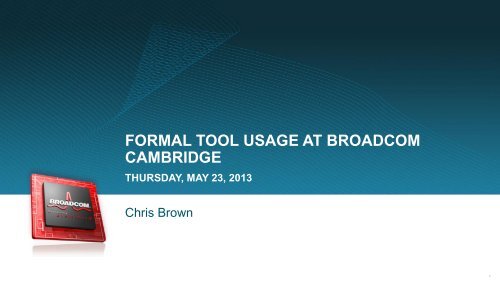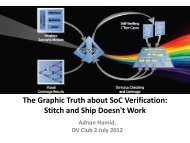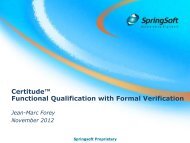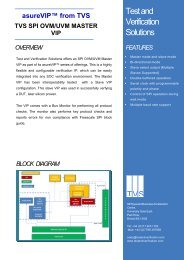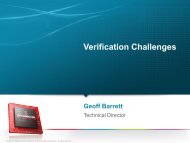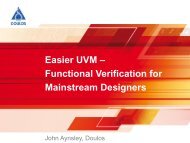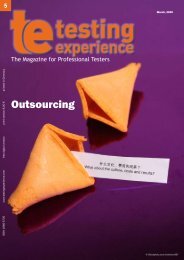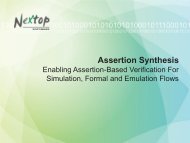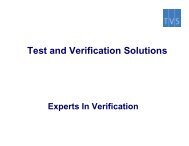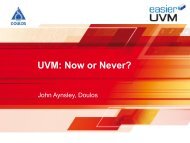Broadcom, Chris Brown - Test and Verification Solutions
Broadcom, Chris Brown - Test and Verification Solutions
Broadcom, Chris Brown - Test and Verification Solutions
Create successful ePaper yourself
Turn your PDF publications into a flip-book with our unique Google optimized e-Paper software.
FORMAL TOOL USAGE AT BROADCOM<br />
CAMBRIDGE<br />
THURSDAY, MAY 23, 2013<br />
<strong>Chris</strong> <strong>Brown</strong><br />
1
AGENDA<br />
• How do we use formal verification tools in Cambridge<br />
• Why don’t we use formal tools more often<br />
• Questions<br />
2
BROADCOM IN CAMBRIDGE<br />
• Is an IP <strong>and</strong> chip-design center.<br />
• There are approximately 150 employees on site.<br />
• We are part of <strong>Broadcom</strong>’s Mobile Product <strong>Solutions</strong> BU.<br />
• We create market-leading video, imaging, <strong>and</strong> 3D solutions for use in mobile<br />
application processors.<br />
• We are the home of the “Raspberry Pi.”<br />
3
FORMAL TOOL USAGE<br />
• Our most successful use of formal tools to date was in diagnosing an issue during<br />
initial silicon bring-up.<br />
• A very rare failure occurred.<br />
• It couldn’t possibly happen, but it did.<br />
• We input the failure data to a formal tool, <strong>and</strong> it was able to point us in the direction of the issue.<br />
• Presented by David Lewsey at Club Formal UK December 2011.<br />
4
CACHE BUG FOUND WITH FORMAL TOOL<br />
• Symptoms<br />
• Writes go missing (rather than going to the wrong place).<br />
• Repeated polling of a shared structure is common to most occurrences.<br />
• Both processors writing to the same line seems to be necessary.<br />
• The assertion:<br />
property only_one_snoop_hit;<br />
@(posedge clk) ~(snoop_hit0 & snoop_hit1);<br />
endproperty<br />
only_one_snoop_hit_ok: assert property (only_one_snoop_hit);<br />
• Result<br />
• Couple of hours runtime (including all the other assertions being checked).<br />
• Debug waveform is 15 clock cycles long.<br />
5
CACHE BUG FOUND WITH FORMAL<br />
• Bug<br />
• The stall-detection logic just shown checked only for tag lookups to the same address in consecutive<br />
cycles.<br />
• It did not account for stalls further down the pipeline.<br />
• It really does work.<br />
• Formal tools found a problem that we had been unable to capture in simulation.<br />
• Debug is easy — the formal tool gave the shortest possible trace.<br />
• The time to set up the tool was comparable to the time to create a new block-level test bench.<br />
6
CURRENT USAGE OF FORMAL TOOLS<br />
• Day-to-day usage<br />
• A fairly small select group of design engineers successfully use formal tools to analyze their designs.<br />
• Usually where a st<strong>and</strong>ard bus protocol is in use.<br />
• If we have had great success with formal tools, why don’t we use them all the time<br />
7
WHY DON’T WE MAKE MORE USE OF FORMAL TOOLS<br />
• Three classes of reasons:<br />
• Excuses<br />
• Real () technical<br />
• Cost<br />
8
EXCUSES<br />
• Excuses are usually based on hearsay <strong>and</strong> not fact.<br />
• Formal tool use has been sold as “snake oil” in the past.<br />
• Don’t you need a PhD in mathematics to do this sort of thing<br />
• Dubious gains<br />
• What part of my simulation workload can I not do if I do formal verification<br />
• Types of design<br />
• Much of my logic is data path, <strong>and</strong> formal tools aren’t good for data path.<br />
• My design is too big.<br />
• Assertion languages are seen as adding little or no value by some.<br />
• Why would I code my design up again in another language I‘ve got more important things to do.<br />
• Because not all blocks have assertions, we can’t use formal tools.<br />
• A long ramp-up time is required to get something running.<br />
9
REAL () TECHNICAL<br />
• How do I know what I’ve achieved<br />
• How do I review it to make sure it is really doing what it should be doing<br />
• My designs really are too big.<br />
• Simulation-based verification people are the norm in the industry, but they don’t have<br />
the knowledge/skills to go straight to using formal tools.<br />
• Many people don’t know how to extract value from these formal tools.<br />
• It is very dependent on how good your assertions are, but there is no automated way to<br />
evaluate this.<br />
10
REAL () TECHNICAL<br />
• It is detached from how we do RTL/software co-verification.<br />
• Our simulation is usually driven from real software.<br />
• Haven’t been able to prove significant things.<br />
• Not good at getting feedback on things that it can’t prove.<br />
• Unproven/unreachable.<br />
• There are unproven/reachable cases where I think that it has got past all the states, but it can’t prove<br />
anything, <strong>and</strong> there seems to be nothing that can help you underst<strong>and</strong> why.<br />
• Is this an issue with the tool, or do we not really underst<strong>and</strong> things<br />
11
THE BOTTOM LINE …<br />
• It isn’t a high enough priority!!!<br />
• Brave decision to tell my boss<br />
• That I will stop doing some UVM/simulation work to focus on formal verification.<br />
• That I need a new member of staff to do formal verification.<br />
• Metrics<br />
• Management tends to focus on <strong>and</strong> prioritize metrics.<br />
• You can measure code/functional coverage for simulation.<br />
• You can measure timing.<br />
• You can measure area.<br />
• You can measure power.<br />
• Can you measure formal verification<br />
12
QUESTIONS<br />
Thank You!<br />
13


